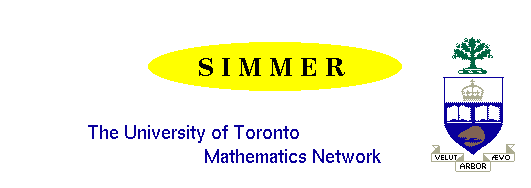

A Mathematical ‘Hodgepodge’
PART II
A 20 X 20 X 20 block is cut up into 8000 non-overlapping unit cubes and a number is assigned to each. It is known that in each column of 20 cubes parallel to any edge of the block, the sum of their numbers is equal to 1. The number of one of the unit cubes is 10. Three 1 X 20 X 20 slices parallel to the faces of the block contain this unit cube. Find the sum of all numbers of the cubes outside of these slices.
The units-digit of the square of an integer is 9 and the tens-digit of this square is 0. Prove that the hundred-digit is even.
Twelve candidates for mayor participate in a TV talk show. At some point a candidate said: "One lie has been told". Another said: "Now two lies have been told". "Now three lies", said a third. This continued until the twelfth said: "Now twelve lies have been told". At this point the moderator ended the discussion. It turned out that at least one of the candidates correctly stated the number of lies told before he made the claim. How many lies were actually told by the candidates?
Let n band m be given positive integers. In one move, a chess piece called an (n,m)-crocodile goes n squares horizontally or vertically and then goes m squares in a perpendicular direction. Prove that the squares of an infinite chessboard can be painted in black and white so that this chess piece always moves from a black to a white one or vice-versa.
Can the product of two consecutive positive integers be equal to the product of two consecutive even positive integers?
Can one place natural numbers at all vertices of a cube in such a way that for every pair of numbers connected by and edge, one will be divisible by the other, and there are no other pairs of numbers with this property?
Numbers are written in all 16 squares of a 4 by 4 table so that the sum of the neighbours of each number is equal to 1 (neighbouring squares are those with a common side). Find the sum of all the numbers in the table.
a. 100 different numbers are written on the blackboard. Prove that you can choose 8 of them so that their arithmetical mean cannot be represented by the arithmetical mean of any 9 of the written numbers.
b. 100 numbers are written on the blackboard. It is known that for any 8 numbers one can find 9 numbers so that the arithmetical mean of the 8 numbers is equal to that of the 9. Prove that all the numbers are equal.It is known that, in a set of k coins of identical appearance, two are counterfeit. The counterfeit coins differ from the true ones by weight. (The true coins all have the same weight, and the weights of the two counterfeit coins are equal to each other.) How can one divide the coins into two groups of equal weight by performing no more than 4 weighing operations with a balance (the balance only shows which of two groups is heavier or shows that they have the same total weight), if: a) k = 32 b) k = 22
The natural numbers a, b, c, d are such that their least common multiple equals a + b + c + d. Prove that abcd is divisible by 3 or by 5 (or by both).
In the spring round of the Tournament of the Towns this year 6 problems were proposed to the senior students of country N. Each problem was solved by exactly 1000 students, but no two students (taken together) succeeded in solving all 6 problems. What was the smallest possible number of senior students from country N in the spring round? (Indicate this number, show that for this number the conditions of the problem can be met, and cannot be met for a smaller number.)
Proposed Problems for your consideration (in pdf format)
Additional problems (in pdf format)
Solutions to the proposed problems (in pdf format)
This page was last updated: December 13, 2000